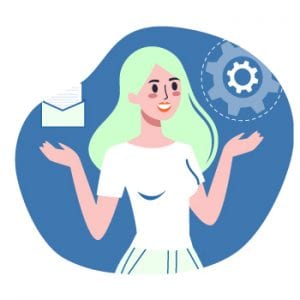Artificial Intelligence Translation and How It’s Changing the Language Industry:
The people of the world cannot survive without the help of linguistic experts because of the language barrier between them. We may not have the solution to a lot of our problems but we can get over the language barrier pretty easily. The abundance of language apps has made it even easier for common people to get access to simple translations. With apps like Google Translate and Microsoft Translator, you can get the translation of foreign language words and sentences in real-time. You can even carry out a conversation with someone with the help of these apps. But how are machine translation and deep learning changing the language industry?
Translation Machines
There are a lot of ways in which machines have made the task of translation easier for linguistic experts. Machines themselves lack the proper understanding of culture. This is why even with neural machine networks, they are not 100% accurate with their translations. But they can help linguistic experts in different ways thanks to deep learning and neural networks. There are computer-assisted translation tools that help human translators in finishing their tasks. They also allow translators to maintain consistency in their work. Translation memory is one such tool that allows translators to access their previously completed projects. This way, experts don’t have to translate the same sentence every time they come across it.
AI Translation Software
AI and computers also help agencies with managing their tasks. There are multiple translation software that make the management system easier for an agency. This allows agencies to handle the workflow in an efficient manner and deliver quality translations to their clients before the deadline. Almost all the professional translators of today use translation tools. From simple options like Google Translate to complex programs like SDL Trados Studio, there are a lot of options available to linguistic experts to choose from.
What Are the Best AI Translators?
Machine translation is not something you can rely on when it comes to official documents. However, that does not make its translation process completely useless. There are multiple instances in which translators powered by machine learning can be helpful for users. Every day, thousands of internet users turn to these translators for help. Whether it is tourists who need to communicate with natives or internet users who want to know the meaning of a foreign word, AI translators can be helpful. Here are the best AI translators today:
-
Google Translate:
The best way for people to make the most of artificial intelligence translation is with the help of Google’s translator regardless of the devices they have. The app and website are completely free. You can get access to multiple features including optical image recognition and voice translation. The translator of Google relies on a neural network to provide users with accurate linguistic assistance. Although the app cannot help you with all the languages of the world, you can get the translation of the most popular ones. Using the app is also pretty easy.
You can choose the source and target language, enter your text, and then get its translation.
The speech recognition feature of Google is getting better day by day. As a result, the app is becoming more accurate. You can also get the translation of websites, articles, and blog posts if you are using Chrome Browser.
-
Microsoft Translator:
You can also get neural machine translation by using Microsoft’s Translator. The app has become quite popular among businessmen lately. The biggest reason behind the popularity of Microsoft Translator is not just the translation quality it offers users but also its features. It is particularly useful for conversations as its results are very quick. People can attend meetings without the help of an interpreter and understand foreign participants. Although Microsoft Translator does not support as many languages as other popular apps, it is still very useful. Many travelers prefer it over other popular machine translation apps.
-
TripLingo:
Although TripLingo is a very helpful translator, the biggest reason behind its popularity is the travel tips it offers. It helps you understand a foreign culture and teaches you to navigate your way through it. Learn very helpful things from TripLingo when you are in a foreign country. You won’t feel lost or confused because of the local customs and traditions as long as you have an app like TripLingo on your phone. Also you will be able to make meaningful connections with the natives if you can understand their culture.
-
iTranslate Voice 3:
If you want your own personal interpreter, then this app is the perfect option. Users can speak into their phone and let the app do the rest. iTranslate Voice 3 not only translates the spoken sentence but also speaks it out loud in the language of your choice. This way, you can carry out a conversation with someone with ease even if you don’t speak their language. The language processing system of the app is pretty advanced.
However, it only supports 42 languages at the moment, which can be a problem for some users. But rest assured that you will be able to get the best translation quality whenever you use iTranslate Voice 3.




What Can Machines Translate?
No matter how advanced our machines become, they will always have shortcomings. All of our computers have their limits to what they can and cannot do. The situation is no different when it comes to the translation process. It is true that software and AI can help you with translation management but it doesn’t mean that they can handle all kinds of source content. For instance, a machine, despite knowing all the terms, will not be able to translate user manuals accurately.
The reason behind that is the cultural and linguistic values of the readers. Each article and document is written in a way so it can be understood by the audience. This isn’t something that can be accomplished by artificial intelligence translation.
Machine learning
Machine learning has improved language apps, but that doesn’t mean they can understand legal documents or carry out official translations. There are ideas that cannot be comprehended by machines. Machines are helpful with everyday conversations and simple repetitive tasks. They can also assist agencies in managing their workflow. This is an example of how human-machine interaction can make things better. However, they cannot come close to the accuracy of human translation. Only language professionals can handle legal and financial documents. Find out more about machine translation software.
Human experts can understand technical specifications and financial jargon. This is why they know how to handle source texts related to all kinds of subject matter. So, if you want accurate official and financial translations, only turn to human experts.
What is the future of Artificial Intelligence Translation?
The language services industry has become very important for individuals and businesses. However, nothing ever stays the same in the world. With apps that can handle source content in hundreds of languages, the translation industry is bound to change. Features like image and voice recognition make apps very useful. However, there are a lot of aspects of real life that cannot be understood by machines. Not to mention the fact that apps cannot support all human languages. This is why we still need the translation industry’s help from time to time.
AI Translation Efficiency
But in the future, machines can become an important tool in the hands of linguistic experts. They can manage their workflow and improve their translation efficiency with the help of language software all thanks to technological innovation. Although the translation industry will not become useless in the future, it will change completely. Neural translation will help linguistic experts with their tasks. Tools like translation memory will make it easier for agencies to finish their projects in a timely fashion. The localization industry will also get a lot of benefits from modern intelligent systems.

Accurate translations are vital in bridging communication gaps across languages. When transitioning content into a target language, human translator play a crucial role in preserving cultural nuances and delivering high-quality translations. They navigate the complexities of idiomatic expressions and cultural context, ensuring the accuracy of the final product. While language models and translation technology aid in the process, human intervention remains essential for nuanced understanding and interpretation. Statistical machine translation and machine translation engines have advanced, yet the human brain still outperforms them in grasping subtleties. Inaccurate translations can arise without proper cultural context or human involvement. However, with the evolution of language technology, the future of translation looks promising, offering instant and accurate translations through Artificial Intelligence (AI) and real-time translation systems. The integration of machine translation tools with human expertise, as seen in CAT tools and translation services offered by companies, promises efficient and accurate translation projects, preserving the essence of communication across languages.
A translation company serves as a hub for language experts and technology to provide efficient and accurate translations. Automatic translation tools enable quick translations, but ensuring translation accuracy requires a blend of human expertise and machine capabilities. Looking to the future, language translation is poised to offer instant translations through advancements in machine translation systems. Real-time communication will benefit from these developments, facilitating seamless interaction across languages. However, maintaining translation accuracy relies on contextual understanding, where human intervention remains essential to capture nuances and cultural subtleties that machines might overlook.
Revolutionizing Language Translation with Neural Machine Translation and Translation Hub
Neural Machine Translation (NMT) has revolutionized the field of language translation by employing deep learning models to translate text between different human languages. Unlike its predecessor, Statistical Machine Translation (SMT), which relied on statistical models and alignment techniques, NMT utilizes neural networks to learn and predict translations directly from input sentences to output sentences. This approach falls under the broader domain of Natural Language Processing (NLP) and computational linguistics, aiming to bridge linguistic gaps across diverse language pairs, including both widely spoken and low-resource languages.
In NMT systems, the input sentence in the source language undergoes a series of transformations guided by sophisticated language models. These models, such as those developed by Sutskever et al., Zhang et al., and Sennrich et al., incorporate multi-head attention mechanisms like dot-product attention to efficiently weigh and combine relevant parts of the source sentence during translation. This attention mechanism, a hallmark of NMT, enables the system to focus on different parts of the input sentence as it generates the corresponding output sentence.
Practical implementations of NMT include platforms like Google Translate and Google Cloud Translation API, which offer extensive language support and robust translation workflows. These platforms leverage AutoML Translation and other technologies to enhance the accuracy and fluency of translations across dozens of languages. Evaluation of machine translations often involves automatic metrics endorsed by the Association for Computational Linguistics (ACL), ensuring that NMT systems meet high standards comparable to human interpreters in certain contexts.
Overall, NMT represents a significant advancement in human language technology, catering to both popular and underrepresented languages through its efficient and adaptive approach to machine translation.
Neural machine translation (NMT) systems represent a state-of-the-art approach in computational linguistics and natural language processing, designed to translate text between different human languages. These systems leverage deep learning architectures, such as recurrent neural networks (RNNs) or transformer models, to directly learn the mapping from input sentences in a source language to output sentences in a target language. Unlike traditional statistical machine translation (SMT) methods, which rely on handcrafted rules and alignments, NMT systems excel in capturing complex linguistic patterns and dependencies. They integrate advanced techniques like attention mechanisms, introduced by researchers such as Sutskever et al. and Vaswani et al., to effectively align and translate words or phrases from the source to the target language. NMT has significantly improved translation quality and fluency across a wide range of language pairs, making it a cornerstone technology in global communication and cross-cultural understanding.
Translation Hub serves as a centralized platform designed to streamline and manage translation workflows within organizations or across multiple users. This hub typically integrates various translation tools, such as machine translation engines, terminology databases, and human translators, to facilitate efficient and accurate translations. It enables users to upload source documents or input sentences in different languages, select target languages, and oversee the entire translation process from start to finish. Translation Hub solutions often incorporate advanced features like collaborative editing, version control, and quality assurance checks to ensure translations meet desired standards. By centralizing translation resources and workflows, Translation Hub enhances productivity, consistency, and scalability in multilingual content management for businesses, institutions, and global enterprises alike.
Translation models, particularly instant voice translators, have revolutionized international travel and customer experiences in recent years. These devices and apps enable seamless communication in diverse languages, overcoming language barriers even in noisy environments such as bustling marketplaces or crowded airports. Custom models tailored to specific dialects or jargon further enhance accuracy and user satisfaction. Despite their advantages, the cost of translation services varies widely, influencing their accessibility and adoption. Voice translation apps and machine translation services continue to evolve, promising more efficient and affordable solutions for global communication needs.
Advanced AI: Enhancing Global Translation Accuracy
Deep learning techniques have revolutionized machine translation technology, enabling machine translation services to deliver increasingly precise translations across languages. The benefits of machine translation lie in its ability to transcend linguistic rules and provide reliable translations even for low-resource languages. Advanced machine translation software analyzes the original language input sentence (or source sentence) to produce translations that not only capture the literal meaning but also consider cultural sensitivity and linguistic nuances. This approach enhances the overall quality of translations, making them more accurate and contextually appropriate for diverse global audiences. As machine translation continues to evolve, its capacity to handle complex linguistic challenges grows, promising continued improvements in cross-cultural communication and understanding.
AI-based translation systems have revolutionized the way translation tasks are approached, offering unprecedented levels of accuracy and efficiency. Mobile apps like Translate, which leverage advanced machine learning and neural machine translation technology, provide users with the ability to perform various types of translations—ranging from everyday communication to specialized fields such as legal language and academic translation. These AI-powered tools utilize natural language processing techniques to handle complex content, including Arabic and English translations, while managing numerous characters per month. Cloud storage facilitates seamless access to translation data, and the App Store offers a variety of translation apps with in-app purchases for advanced features. The incorporation of Translation APIs enhances the flexibility of these systems, ensuring high-quality results across different types of content. Moreover, the assessment of translation quality remains crucial in Translation Studies, as it helps in refining the artificial intelligence translation program and improving cultural references and alternative translations.
In the realm of academic translation, teaching methodologies and resources, such as those found in Procedia, play a crucial role in honing the skills required to render accurate and meaningful translations. An English phrase, particularly when it contains ambiguous phrases, presents a challenge that demands careful analysis and precise interpretation. Effective teaching emphasizes the importance of understanding the context to ensure the correct meanings are conveyed. Instructors guide students in addressing these ambiguities and producing translations that faithfully capture the intended message. To support learning, supplementary materials such as an appendix file can provide examples and exercises, facilitating a deeper understanding of how to achieve accurate meaning. By practicing these techniques on a month-per-user basis, students refine their ability to navigate complex translations and improve their overall proficiency in academic translation.
FREQUENLY ASKED QUESDTIONS
- AI translation utilizes neural networks and machine learning algorithms to analyze and translate text from one language to another. These systems learn from vast amounts of data to generate accurate translations.
- AI translations have made significant advancements in accuracy, but they may still struggle with nuances, idiomatic expressions, and context-dependent translations. Human translations, particularly for complex or culturally sensitive content, often offer higher accuracy.
- Many AI translation systems support a wide range of languages, including commonly spoken languages like English, Spanish, Chinese, and French, as well as less widely spoken languages depending on the system’s training data.
- Security measures vary among AI translation providers. It’s essential to choose a reputable provider that prioritizes data privacy and offers encryption and other security features to protect sensitive information during translation.
- Some AI translation systems are trained on specific domains or industries and can accurately translate technical terminology. However, customized training or human post-editing may be necessary for highly specialized content.








